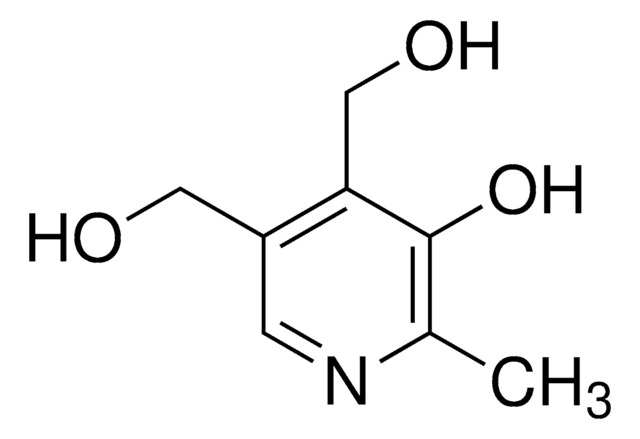T1270
Thiamine hydrochloride
BioReagent, suitable for cell culture, suitable for insect cell culture, suitable for plant cell culture
Synonym(s):
Aneurine hydrochloride, Vitamin B1 hydrochloride
About This Item
Recommended Products
biological source
synthetic (organic)
Quality Level
product line
BioReagent
assay
≥99.0% (HPLC)
form
powder
mol wt
Mw 337.27 g/mol
technique(s)
cell culture | insect: suitable
cell culture | mammalian: suitable
cell culture | plant: suitable
color
white
mp
250 °C (dec.) (lit.)
solubility
H2O: 50 mg/mL, clear, colorless
application(s)
agriculture
SMILES string
CC1=NC(N)=C(C[N+]2=CSC(CCO)=C2C)C=N1.Cl.[Cl-]
InChI
1S/C12H17N4OS.2ClH/c1-8-11(3-4-17)18-7-16(8)6-10-5-14-9(2)15-12(10)13;;/h5,7,17H,3-4,6H2,1-2H3,(H2,13,14,15);2*1H/q+1;;/p-1
InChI key
DPJRMOMPQZCRJU-UHFFFAOYSA-M
Looking for similar products? Visit Product Comparison Guide
General description
Application
- of the vitamin-concentrated stock solution for the preparation of Hv-Ca medium for culturing Haloferax volcanii
- of the tris-acetate-phosphate (TAP) medium for culturing Chlamydomonas nivalis
- of modified Bold 3N medium for culturing Chlorella minutissima
Biochem/physiol Actions
signalword
Warning
hcodes
Hazard Classifications
Eye Irrit. 2
Storage Class
11 - Combustible Solids
wgk_germany
WGK 1
flash_point_f
Not applicable
flash_point_c
Not applicable
ppe
Eyeshields, Gloves, type N95 (US)
Certificates of Analysis (COA)
Search for Certificates of Analysis (COA) by entering the products Lot/Batch Number. Lot and Batch Numbers can be found on a product’s label following the words ‘Lot’ or ‘Batch’.
Already Own This Product?
Find documentation for the products that you have recently purchased in the Document Library.
Customers Also Viewed
Articles
How thiamine and other cell culture components affect the performance of serum-free, protein-free cell culture systems used for biomanufacturing heterologous proteins including monoclonal antibodies. The page introduces the in vitro chemistry and biochemistry of thiamine.
Neoplastic cells are highly dependent on the de novo synthesis of nucleotides to maintain sufficient pools to support DNA replication and the production of RNA.
Our team of scientists has experience in all areas of research including Life Science, Material Science, Chemical Synthesis, Chromatography, Analytical and many others.
Contact Technical Service







